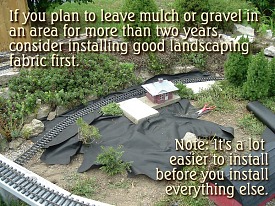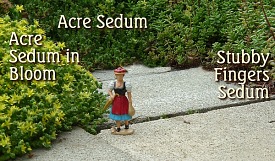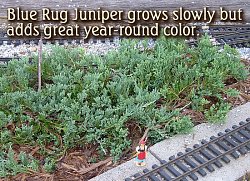 | |||
 |
 |  | |
 |  | ||
 |  | ||
 |  | ||
 |  | ||

| Please Read: How to Help Our Site at No Cost to You - Some of our articles contain recommendations for products we like and vendors we personally trust. Some of those vendors may pay us a very small commission if you click on a link and buy their products. This costs you nothing at all and helps offset the costs of what we do. So if we point you to something you decide to buy later, please make certain you come back through our site and click on the link directly. Thanks. |
| This Site is a Cookie-Free Zone - Except for discussion forums that you have to expressly registor for, none of our pages use cookies of any kind. Some of the vendors we link to do, but that won't affect you unless you click on a link to their pages. Your continued use of this page indicates that you agree to our policy. For details, click here. |


|
 Ground Cover 101
By definition, ground cover hides the soil. It also keeps a relatively low profile-a "ground cover" in landscaping seldom exceeds 18". In garden railroading, we try to keep our groundcovers much shorter, so they don't hide our buildings and people. And there are some great choices out there. Often visitors or new garden railroaders are struck with the attractiveness of the thymes, miniature sedums, and other plants surrounding the buildings and tracks of established railroads. What they don't factor in is that such plantings may have taken years to establish, and don't necessarily provide an immediate solution to all the ground cover needs of a young layout. On behalf of the beginner or for a new garden railroad, this article briefly reviews some approaches that won't break the bank and won't preclude you trying other approaches later on. Technically speaking, ground covers include lawn grass, gravel, mulch, and a wide variety of plants. Any of these solutions is better than dirt (or dirt-and-weeds) for most purposes, but they meet different needs. An ideal ground-cover for a garden railroad should have at least the following characteristics:
If you choose a living ground-cover, add the following characteristics to the above list:
No matter how attractive any kind of ground cover may be, nothing meets all of the above needs, especially when you're first starting out. But you have to do something. So let's take a look at the advantages and disadvantages of a few solutions. Lawn GrassDon't laugh. If you plan to have some distance of track running at ground level, designing that stretch so you can mow up against it (or even over it, if you're careful) can save you a lot of headaches while you're getting things established. Many notable garden railroads have grassy sections connecting the sections with all the scenery and fancy plants. Folks who use 20' diameter curves especially find lawn grass a reasonable alternative to landscaping or gardening all that right-of-way. In its favor, if you choose a lawn grass that is suitable for your climate, you will find that you can easily maintain it with tools you already own, it is self-replenishing, and it reduces weed growth (not to mention that there are a host of lawn-care products available). Okay, maybe you eventually want to have something fancier, but if you are just starting out and can leave part of your lawn in, er, lawn, you may find this a viable solution, at least until you've got everything else under control. Obviously, though, lawn grass is not the best solution for small or raised segments. Gravel or MulchI put these into one category because they have several similarities. For example, they both require you to haul them in, and they both do the best job of reducing weeds when you install them over good landscaping fabric. Unlike plants you have to nurture and wait to grow, gravel or mulch looks as good as it ever will the day you put it down. We have a saying in our house, though: "Mulch covers a multitude of sins." If you have a big stretch that you haven't gotten around to landscaping yet, a few cubic feet of mulch (maybe interrupted by a few inexpensive dwarf or low-lying conifers) will give an amazingly finished look to it in a matter of minutes. I like to choose mulch that is finely chopped so it doesn't look like piles of logs next to my equipment. Also, cedar or cypruss mulch tend to stick around longer and withstand wood-loving insects better than hardwood mulch. So consider cedar or cypress if you expect to leave the mulch down a little while or if you're working against your house's foundation.
I have plenty of fine plants growing elsewhere, so I don't really need to have anything dramatic in this corner anyway. And the "landscaping fabric under mulch or gravel" approach saved me a lot of work around the swimming pool this year, so I'm confident it will work for me here, once I get time to get it all down, re-mulched, and re-ballasted. I've included this photo and this story just to show that I don't always get things right the first time or even the second or third time. Also to demonstrate why I now recommend to beginning garden railroaders that they put good garden fabric down first. It's easier to peel away a little at a time as the plants do take over than it is to put down around plants and track and things. In addition, don't bother with the landscaping fabric that's only guaranteed for a year or five, unless you want to do this all over again in a year or three. Finally, this is a reminder not to panic if you try something and it doesn't work out, even if it worked out for you before. Your garden is alive, after all. The rest of this article deals with the living, breathing, groundcovers, and shows you some parts of my garden railroad that did work out. Living Ground CoversEventually most garden railroaders try to get some low-lying plants to represent grass and bushes around their tracks and buildings. Here is where the gardening part of garden railroading comes in, as well as a certain amount of frustration. Let's face it, plants are a whole lot less predictable than mulch or gravel. Keep your eyes open and a notebook handy when you visit garden railroads and garden centers in your area; ask a lot of questions. But don't spend a fortune on miniature plants before you've tried out a few different kinds and find out what works for you in your yard.
There are many choices available, but three basic kinds of living groundcovers that have worked best for me, and which are usually available at area nurseries are: thymes, sedums, and junipers. These also seem to work for most people in the Midwest and Northeast; however, they may not work as well in your soil or in your microclimate as they do for me. Think of the following plants as examples of the sort of things you might look for, and learn what garden railroaders in your area are using successfully. (If you are very polite, the property owners may even give you a start or two.)
Other Plants You May TryMany garden railroaders in warmer climates have good luck with Baby Tears. Some folks in zones as cool as ours (zone 5.5) have had good luck with Corsican Mint as well. It doesn't grow in my neighborhood (ask your friends from the Midwest about the "north-of-I-70 phenomenon") but people who have kept theirs going claim that it spreads nicely once it gets established. Again, before you invest a fortune or a great many hours trying to keep something alive that isn't really that useful in your area, see what other garden railroaders near you are using successfully.Don't be frustrated if a groundcover don't exactly take off the first year, though. There's a saying among gardeners about perennials after transplanting: the first year they sleep, the second year they creep. But their roots are getting established the whole time and they will eventually spread out where you need them to as long as you keep them alive. A Note About Color Having a Y chromosone, when I first started sprinkling groundcovers around my railroad, I planted them according to the size I expected them to get and the effect I was going for in different areas: field, scrub brush, forest, etc. So I had deep green Creeping Thyme interspersed with pale blue-green Blue Spruce Sedum. My wife pointed out how much better the Woolly Thyme matched the color of the Blue Spruce Sedum, and the trouble was she was right. So I did a little moving things around, and it probably looks much better to people who aren't color-blind. So in case you're into that sort of thing, I'll mention that groundcovers can be divided according to color as well as species and growing habits. The following list will include plants I haven't profiled here, in case you want to try them as well. Having a Y chromosone, when I first started sprinkling groundcovers around my railroad, I planted them according to the size I expected them to get and the effect I was going for in different areas: field, scrub brush, forest, etc. So I had deep green Creeping Thyme interspersed with pale blue-green Blue Spruce Sedum. My wife pointed out how much better the Woolly Thyme matched the color of the Blue Spruce Sedum, and the trouble was she was right. So I did a little moving things around, and it probably looks much better to people who aren't color-blind. So in case you're into that sort of thing, I'll mention that groundcovers can be divided according to color as well as species and growing habits. The following list will include plants I haven't profiled here, in case you want to try them as well.
Note: This list has nothing to do with the color of the flowers on these plants. In most cases, the flowers don't last long; consider them a bonus (Golden Crown Sedum) or a nuisance (Blue Spruce Sedum) as you prefer, and plan on dead-heading the larger Sedums a couple weeks after they start to bloom. In addition, the exact hue of the plants and their flowers will be affected by chemistry, amount of daylight, and amount of rain, so, like everything else in this article, your mileage will vary. Please e-mail me with additions or corrections.
Ground Covers from HellIf you have gardeners in your family, or are starting your railroad in an established garden, you may have or may unwillingly acquire ground covers that are not suitable for your garden railroads. You can't afford to be polite when someone clucks over an unbroken bank of mulch and gives you a nice start of some groundcover that is "perfectly useful" in traditional gardening or landscaping, but which may become intrusive on your railroad. I have had several plants leapfrog other groundcovers I liked better, as well as roadbed, "parking lots," and in some cases small buildings, to establish starts several places I didn't want them, without bothering to fill in where I really wanted. These included ajuga, periwinkle (myrtle), ivy, vining euonimous, blue star creeper, and pachysandra. After I published this list, several people e-mailed me to claim that they had had found one or another of these plants to be quite polite and useful on their railroad. So, once again, your mileage will vary. The point is that if you try a new groundcover you aren't familiar with, consider using it first in some corner where it can't easily spread to other parts of your garden, in case it turns out to be a bad match for your needs. Frankly, most relatively hardy ground covers are far more intrusive on a garden railroad (where you're trying to water, etc., responsibly) than they are elsewhere. So a plant that has been stable and polite for a decade of neglect around your front porch steps may grow like kudzu around your pond.In addition, it's common for vining plants like ivy and pachysandra not to establish well until something else is holding the soil in place for them. So you can have a bank of pachysandra limping along for a year or five until something you like better takes root; then the pachysandra takes off, thank you very much. And such plants develop such incredible root systems that you can't pull them out without destroying almost everything else in the vicinity. So when Grandma offers you some Baltic Ivy just to "temporarily" fill in a gap in your greenery, learn to "Just say no." ConclusionThere are no hard-and-fast rules. Just don't expect everything you try to work out just right, especially the first year or two you break soil or try a new variety. Take your time, try things out a little at a time to see what works for you, and avoid shortcuts you may regret later. Above all, remember that you're the person who eventually has to be satisfied with how all these things come together. Best of luck! Keep in TouchFinally, please let us know about your ongoing projects. Ask questions, send corrections, suggest article ideas, send photos, whatever you think will help you or your fellow railroaders. In the meantime, enjoy your trains, and especially enjoy any time you have with your family in the coming weeks, Paul Race To read more, or to look at recommended Garden Railroading and Big Indoor Train products, please click on the index pages below.
|


|
Note: Family Garden TrainsTM, Garden Train StoreTM, Big Christmas TrainsTM, BIG Indoor TrainsTM, and BIG Train StoreTM are trademarks of
Breakthrough Communications (btcomm.com). All information, data, text, and illustrations on this web site are
Copyright (c) 1999, 2000, 2001, 2002, 2003, 2004, 2005, 2006, 2007, 2008, 2009, 2010, 2011, 2012, 2013, 2014, 2015, 2016, 2017, 2018, 2019, 2020, 2021 by
Paul D. Race. Reuse or republication without prior written permission is specifically
forbidden.
Family Garden Trains is a participant in the Amazon Services LLC Associates Program,
an affiliate advertising program designed to provide a means for sites to earn advertising
fees by advertising and linking to amazon.com.
For more information, please contact us
 |  |
| Visit related pages and affiliated sites: | |||||
| - Trains and Hobbies - | |||||
 |  |
 |
 |
 |  |
 |

|

|  |
 |

|
| - Christmas Memories and Collectibles - | |||||
 |

|
 |

|
 |

|
| - Family Activities and Crafts - | |||||
 |

|

|

|

|

|
| - Music - | |||||

|
 |
 |

|

|

|

|

|

|

|

|

|

|

|

|

|

|

|









